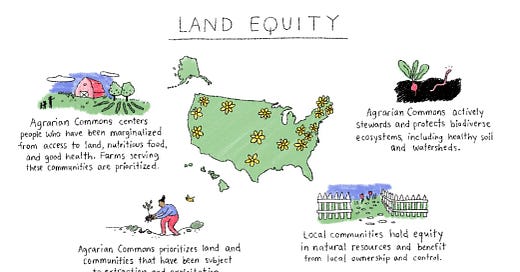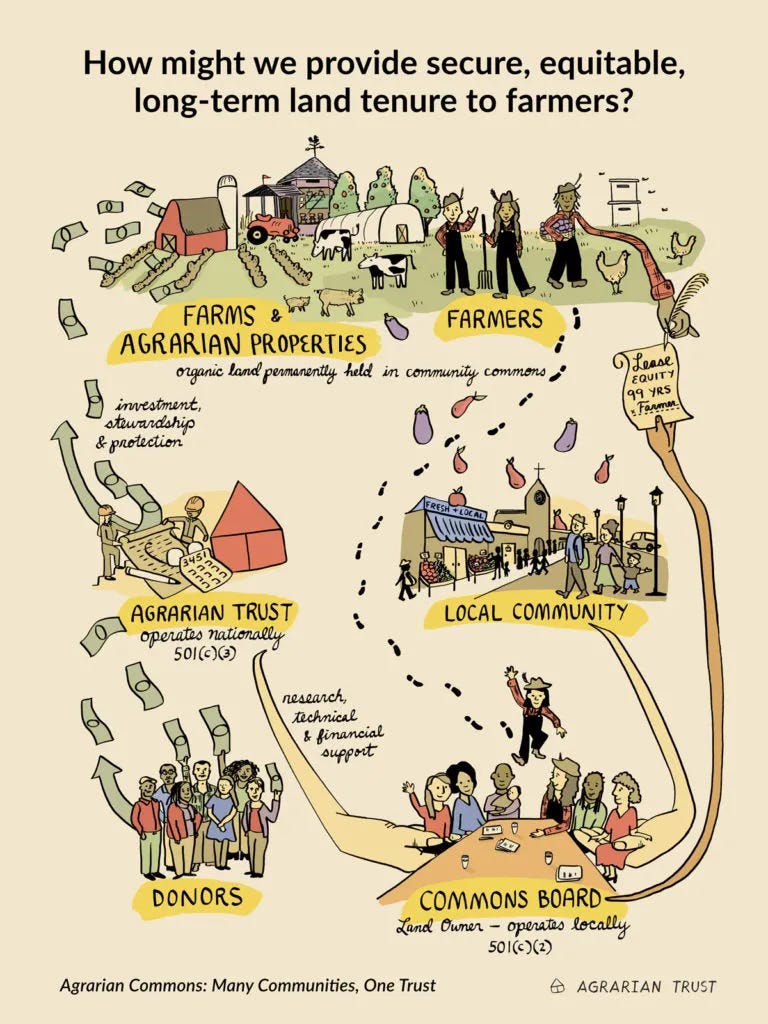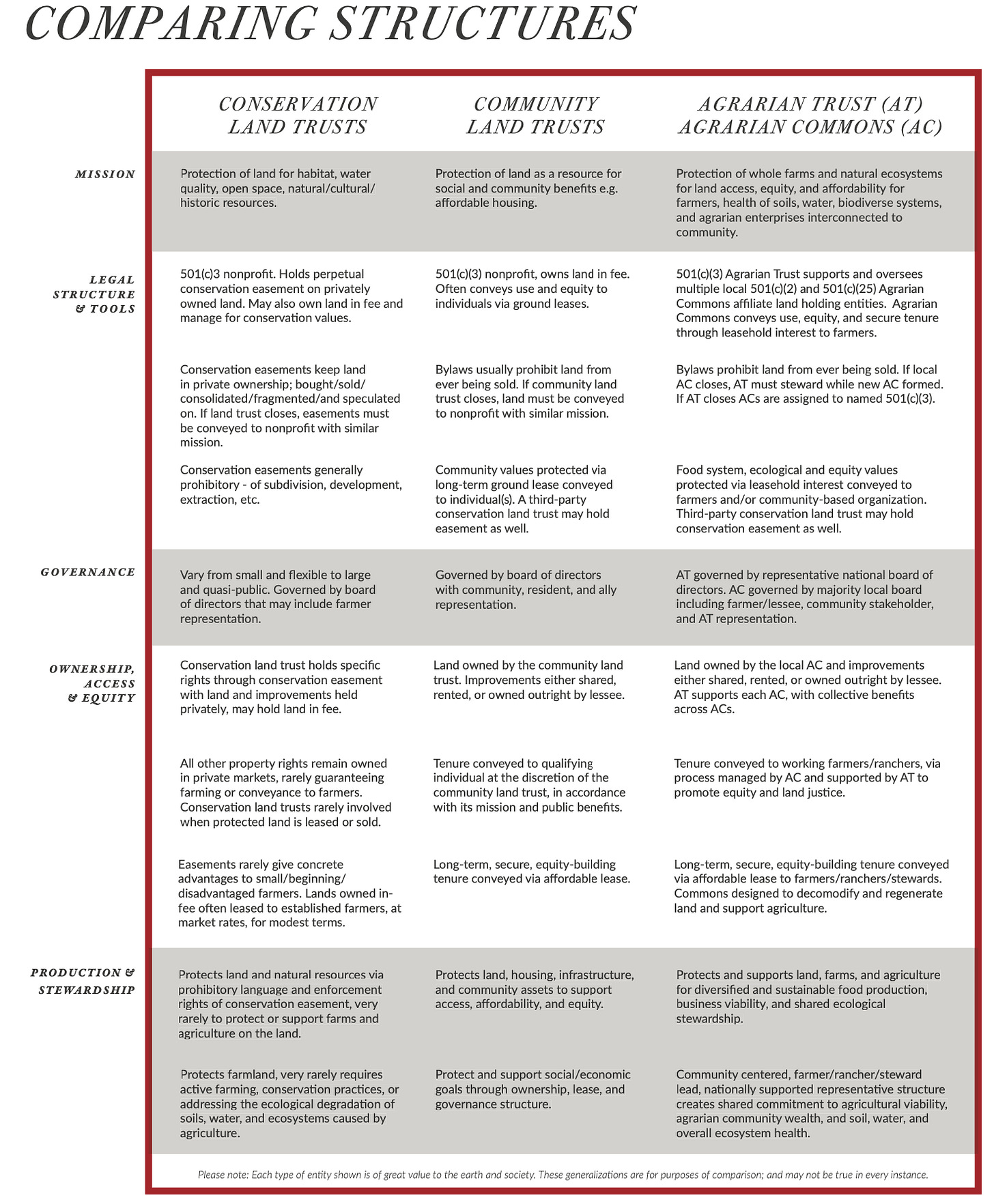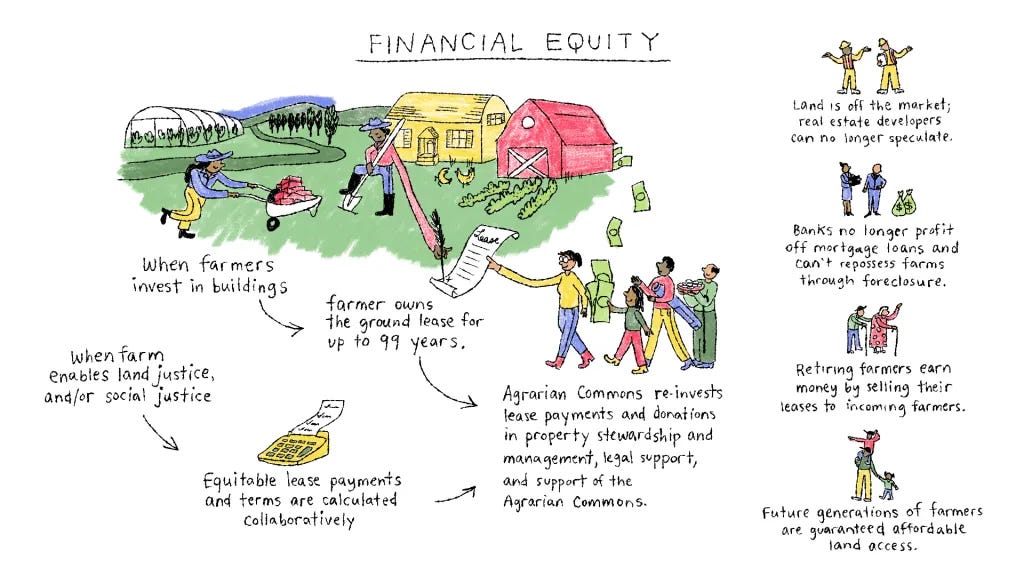Funding Collective Land Ownership: Agrarian Commons
Unsettling subscriptions help fund important experiments in shared land stewardship
Are we sufficiently past the flood of Giving Tuesday donation appeals and cyber week marketing emails such that you have actually found this message in your inbox? I hope so, because I've really been looking forward to sharing news about the work your subscriptions here are helping support.
10% of every paid subscription to Unsettling (after Substack and card processing fees) goes back out to groups doing work on the themes we cover here, be it changing our relationship to place and land, expanding indigenous sovereignty, or advocating for reparations.
The funds from the first half of this year all went out to the group Agrarian Trust, and specifically to one of the projects under their Agrarian Commons program, the Central Virginia Agrarian Commons.1
Agrarian Trust (with a solid support from the legal minds at the Solidarity Economy Law Center) has, over the past three years, developed and implemented a new framework for removing land from the market and putting it into collective ownership. The focus is on farmland, as the biggest challenge to small farms right now is access to land. That is especially true for young farmers, and is becoming even more difficult as Wall Street and the likes of Bill Gates seek to consolidate ownership of agricultural lands and treat it as an investment vehicle rather than as a basic and necessary component in our food supply and in the autonomy of local communities.
An Agrarian Commons takes a piece of farmland and puts it into a trust structured with a board of community members who help look after the land and lease it, long-term, to a local farmer. The long-term lease guarantees land access to the farmers regardless of what might be happening to fluctuating land values in changing markets, while the board ensures that even if a given farm business ends, or an individual farmer retires, the land in question remains both in use for community-based agriculture and affordable.
Agrarian Trust has created a set of visuals to show how all the different pieces of this effort work together, and comparing the Agrarian Commons model to other forms of land trusts:
For those who want more detail, this breakdown is useful:
A question that often arises is how farmers can build financial equity in this scenario, given that they themselves do not own the land. Here’s a few answers from Agrarian Trust on the matter:
Long-term tenure: Agrarian Trust requires the maximum legal lease term. In most states this is a 99-year lease, and in some states it is a 15-year lease. This ensures farmers can farm as long as they desire, with the ability to pass the farm on to the next generation.
The ground lease is the most commonly utilized tool through which the Commons introduces equity building for farmers. Under a ground lease, farmers retain ownership of buildings and infrastructure they construct and invest in on the land. So, while the farmer does not own the land, the absence of a mortgage payment frees them up to invest in critical infrastructure which they retain ownership of and which represents built equity.
Farmers enter into 99-year (or the maximum as per state law) renewable leases with Agrarian Commons, and farmers may be able to sell the value of their leasehold interest.
But the Agrarian Commons model is just as concerned with other forms of equity:
One can really see all these different forms of equity coming into play in the Central Virginia Agrarian Commons Urban Farm. This particular project is located in an area with few options for healthy food and where many residents experience food insecurity. Located next to an elementary school, the farm will provide produce for students and their families and will also serve as an education site, with additional plans to become an incubator for other farmers. The farm is an intentionally BIPOC-led enterprise, drawing on the experience of several longtime residents who are already farmers and educators in this particular neighborhood near Richmond, Virginia.
The Central Virginia Commons successfully completed a round of fundraising earlier this year (when our contribution here was sent in) to acquire land for the project, and the group is expanding its plans for infrastructure onsite, which will now include a community kitchen. Updates and more info are all available at https://www.agrariantrust.org/fundraiser/support-the-central-virginia-agrarian-commons-urban-farm-acquisition/
Part of what I find exciting about the Agrarian Commons model is its expansion of ideas about what can be held in common, and the uses a community trust might be put to. What embodies American notions of private business and rugged individualism like the “family farm”? The commons model puts away that tired trope, showing instead shows how community-held goods and individual efforts can complement one another, while goading us to imagine what else might be more accessible and secure—and maybe even more fun—if we did it together, not alone.
I hope you’ll go poke about on the project page as well as the Agrarian Trust website (https://www.agrariantrust.org).
And if you like the idea of supporting both work like this and writing aligned with such efforts, please consider becoming a paying subscriber to the Unsettling newsletter. A big thanks to all of you who already contribute. I aim to avoid paywalls around here, making this something everyone can read, and your paid subscriptions help make that possible and also ensure I can keep dedicating some of my time to this project.
Thanks for reading. Until next time,
Meg
Funds from the second half of 2022 will go out before year’s end to another project; if you have groups you think particularly worthy of support, let me know! Email your suggestions to unsettling@substack.com.









